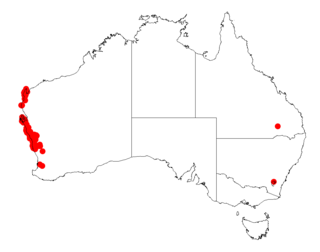
Acacia acanthoclada, commonly known as harrow wattle, is a species of flowering plant in the family Fabaceae and is endemic to southern continental Australia. It is a low, highly branched, spreading and spiny shrub with wedge-shaped to triangular or egg-shaped phyllodes with the narrower end towards the base, and spherical heads of up to 30 flowers, and linear, spirally-coiled pods.

Acacia acinacea, commonly known as gold dust wattle, wreath wattle or round-leaf wattle. is a species of flowering plant in the family Fabaceae and is endemic to south-eastern continental Australia. It is a bushy or straggling shrub with asymmetric, narrowly oblong to broadly egg-shaped phyllodes with the narrower end towards the base, flowers arranged in a spherical heads 4.0–4.5 mm (0.16–0.18 in) in diameter with 8 to 20 flowers, and a spirally coiled to twisted pods up to 3.0–4.5 mm (0.12–0.18 in) long.

Acacia bifaria is a shrub belonging to the genus Acacia. It is native to an area along the south coast of Western Australia.

Acacia cochlocarpa is a shrub belonging to the genus Acacia and the subgenus Juliflorae. It is native to Western Australia.

Acacia acanthaster is a species of flowering plant in the family Fabaceae and is endemic to the south-west of Western Australia. It is a rigid, densely-branched, domed shrub with flat, linear phyllodes, spherical heads of golden-yellow flowers, and curved pods that resemble a string of beads.

Acacia acuaria is a species of flowering plant in the family Fabaceae and is endemic to the south-western of Western Australia. It is a rounded or diffuse to spreading, prickly shrub with sharply pointed, rigid, needle-shaped phyllodes, flowers arranged in more or less spherical heads of 14 to 23 flowers, and strongly curved or openly coiled pods up to 50 mm (2.0 in) long.
Acacia blaxellii, also known as Blaxell's wattle, is a shrub belonging to the genus Acacia and the subgenus Phyllodineae endemic to Western Australia.

Acacia concolorans is a shrub belonging to the genus Acacia and the subgenus Phyllodineae that is endemic to Western Australia.

Acacia dorsenna is a shrub belonging to the genus Acacia and the subgenus Phyllodineae that is endemic to Western Australia.

Acacia errabunda is a shrub belonging to the genus Acacia and the subgenus Phyllodineae native to Western Australia.

Acacia glutinosissima is a shrub belonging to the genus Acacia and the subgenus Phyllodineae that is endemic to western Australia.
Acacia muriculata, commonly known as Koolanooka wattle, is a shrub belonging to the genus Acacia and the subgenus Phyllodineae that is endemic to a small area of south western Australia.

Acacia puncticulata is a shrub of the genus Acacia and the subgenus Phyllodineae that is endemic to an area along the west coast of Australia.

Acacia simulans is a shrub of the genus Acacia and the subgenus Phyllodineae that is endemic to south western Australia.

Acacia spathulifolia commonly known as Gold carpet or the Gold carpet wattle is a shrub of the genus Acacia and the subgenus Phyllodineae that is endemic to coastal parts of western Australia.

Acacia splendens is a tree or shrub of the genus Acacia and the subgenus Phyllodineae that is endemic to a small area of western Australia.

Acacia cassicula is a shrub of the genus Acacia and the subgenus Plurinerves that is endemic to an area of south western Australia.
Acacia graciliformis, also known as Koolanooka Delicate wattle, is a shrub of the genus Acacia and the subgenus Plurinerves that is endemic to a small area in western Australia.

Acacia hadrophylla is a shrub of the genus Acacia and the subgenus Plurinerves that is endemic to south western Australia.

Acacia multisiliqua is a shrub or tree of the genus Acacia and the subgenus Plurinerves that is endemic to northern Australia.


















